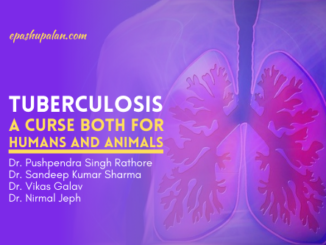Bovine viral diarrhoea is a viral disease that affects cattle worldwide causing significant economic losses in both dairy and beef cattle through its effects on production and reproduction. Disease is seen in different clinical outcomes that range from subclinical infections to the more severe presentations including abortion, infertility, and the fatal mucosal disease. Disease is highly immuno-suppressive and secondary respiratory and enteric complications often occur.
Etiology
Disease is caused by Bovine Viral Diarrhea virus of pestivirus genus of family Flaviviridae. There are two antigenically distinct genotypes of BVDV, type 1 and type 2 on the basis of sequences.
Epidemiology: BVDV is endemic and occur worldwide
Transmission
BVDV can be transmitted from infected to susceptible cattle in several ways. BVDV is secreted and excreted by animal suffering from disease. Transmission to heifers and cows may also occur venereally, via artificial insemination or during embryo transfer.
Pathogenesis of disease
Following entry and contact with the mucosa of the oral or nasal cavities or the reproductive tract, BVDV replicates in epithelial cells and has a predilection for the palatine tonsil and the nasal mucosa. From here, the virus spreads to regional lymph nodes before a viraemia becomes established. Virus can be disseminated free in the blood, or associated with leukocytes, particularly lymphocytes and monocytes.
Clinical signs
Diarrhoea is a key clinical feature in BVDV infection, but it is not a major clinical sign. Clinical presentation can vary from subclinical disease to the fatal muscosal disease. Outcome of BVDV infection depend on pregnancy status, stage of gestation and immunity.
In non-pregnant cattle immunocompetent animal, BVD is normally mild with no obvious clinical signs. In this subclinical form is seen in which body temperature may marginally rise and mild leukopenia and agalactia may be seen. When clinical disease occur in these animals, morbidity is high amongst cattle of 6-12 months of age and pyrexia and leukopenia is seen. Clinical signs more commonly include depression, anorexia, occulo-nasal discharge, decreased milk production and pneumonia like signs. Because of significant leukopenia, hampering the host’s defences against invading pathogens leading to immunosupression
Haemorrhagic syndrome occurs due to BVDV-2 is characterised by severe thrombocytopaenia leading to haematochezia, petechiation and epistaxis.
In pregnant animals, acute BVDV infection occurs and animal may show any of the clinical manifestations that are seen in non-pregnant animals. BVDV is able to cross the placenta and infect the developing foetus and so there may be additional outcomes of infection that depend on the stage of gestation.
- Infection at the time of insemination: reduced conception rates and early embryonic death is increased
- Foetal infection in the first trimester (50-100 days): Result in death or birth of persistently infected (PI) calves.
- Transplacental infection between days 100 and 150: Congenital defects occur and common congenital abnormalities include defects of the thymus, ocular changes and cerebellar hypoplasia. Calves with cerebellar hypoplasia ataxic, reluctant to stand and may suffer tremors, and ocular pathology often causes blindness and cataracts.
- Infection in the third trimester trimester (over 180-200 days): Birth to seropositive calves.
Clinical picture in Mucosal Disease
Persistent infection with BVDV is the prerequisite for developing mucosal disease. Mucosal disease arises from superinfection of persistently infected animals with a cytopathic virus antigenically similar to the original, non-cytopathic strain persisting in the animal. Mucosal disease is fatal condition seen in 6-18 month-old cattle. Disease follows a course of several days to weeks and intially presents as pyrexia, depression and weakness. Lesions are localised to mucosal surfaces which include the oral mucosa, tongue, external nares, nasal cavities and conjunctiva, where large lesions cause excessive salivation, lacrimation, and oculo-nasal discharge. The coronet and interdigital surface causing the animal to become disinclined to walk and eventually recumbent.
Diagnosis
- ELISA
- Viral isolation
- Immunohistochemistry
- PCR assay
Treatment
Acute BVDV infection is usually mild and does not require treatment, and treatment of more severe cases is symptomatic and supportive
Control of disease
Effective biosecurity, strategic testing, elimination of persistently infected animals, and vaccination strategies can help in controlling the infection.
|
The content of the articles are accurate and true to the best of the author’s knowledge. It is not meant to substitute for diagnosis, prognosis, treatment, prescription, or formal and individualized advice from a veterinary medical professional. Animals exhibiting signs and symptoms of distress should be seen by a veterinarian immediately. |






Very good article